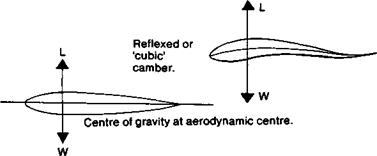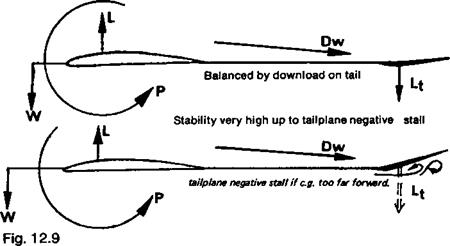THE LIFTING TAIL
In Figure 12.6 a trim very commonly used for free-flight models is shown. The centre of gravity is located well aft, even beyond the 33% mean chord point, so that at low speeds there is an excess nose-up pitching couple of the weight and lift. To balance this, the tailplane must carry an upload and is usually cambered appropriately for this. Although this trim is almost universal on these models, it has no advantages in terms of drag saving. The tailplane produces tip vortices and the lift force generated by the tail is not enough in proportion to make this penalty worthwhile. Every attempt to prove the opposite has been proved mathematically fallacious. In contest models the fallacy is more than usually apparent because, as will appear, to provide stability with this trim requires a larger tail contribution than other trims, so there is a penalty in terms of profile drag as well as vortex drag. Every increase of tail area robs the mainplane of an equivalent amount Yet the wing is invariably more efficient than the tail, producing its lift for a smaller relative drag penalty.
|
|
|
Symmetrical profile |
|
Fig. 12.7 A symmetrical wing or one with ‘cubic’ camber, has zero pitching moment and balance is achieved with no auxiliary wing. Stability problems arise. |
|
|
|
flight trim, the tailplane will pass through a zero load point
















